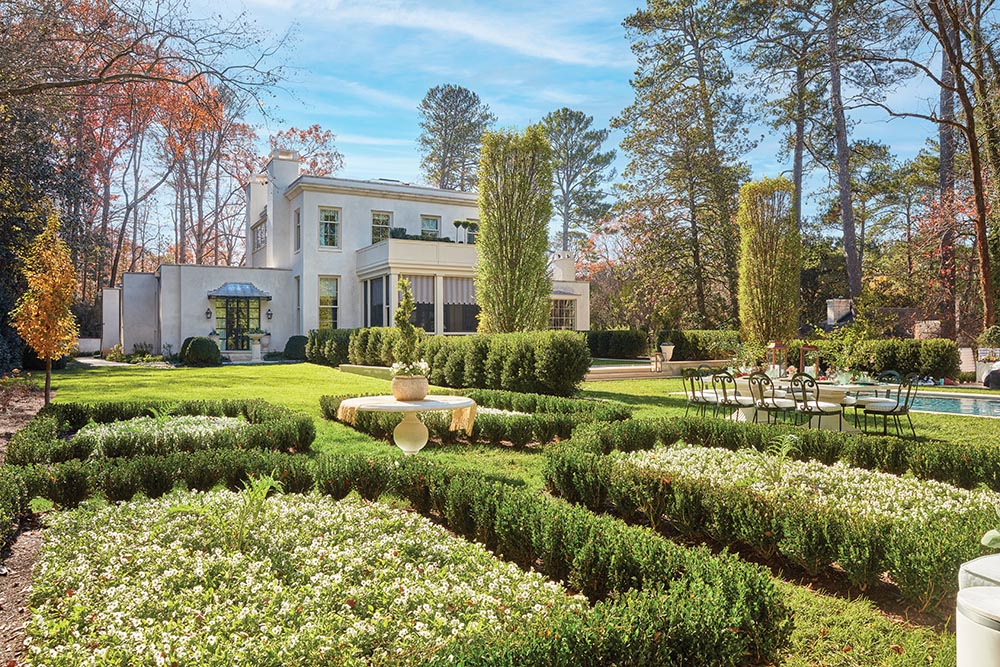
Photo courtesy of John Howard
Flower: When chatting with design professionals, we always want a little backstory. Did you grow up gardening or in a design-centric home?”
John Howard: I grew up in Atlanta in a mid-century house with modest gardens. I loved to work outside, plant things, and build things. I always had an interest in architecture and did drafting for architects and engineers during my high school and college years. I also liked to draw and do graphic design, and I was supported by my family in all my artistic endeavors.
What was your first indication that you would design landscapes?
I discovered landscape architecture when I was in high school, which combined many of my interests including architecture, horticulture, and being outside. It was an obvious choice to study landscape architecture in college. Fortunately, the University of Georgia has one of the top programs in the country.
What would you describe as your defining project—the one where you said, “Okay, I can do this”?
There was not one defining project but, rather, a series of progressive projects that each seemed like the next step along the way. Design came naturally, and each design challenge was exciting. Today, my favorite projects are always the ones in which I’m currently engaged.

The showhouse’s formal plantings aren’t limited to the grounds. The wings on either side of the house feature flat rooftops with sedum “parterres."
Where have you been most inspired by landscapes?
I have been most inspired by my travels abroad. The landscapes and gardens of Europe have had an immense impact on my personal style and perspective. Travel continues to be my biggest teacher, so it’s a part of my schedule every year. Just this year, I have spent time in the South of France, Belgium, England, Ireland, and Italy. The English country manor gardens are some of my favorites, and Hidcote Manor Garden and Bourton House Garden in the Cotswolds rate at the top.
Are there one or two design heroes of yours who have really influenced your aesthetic and philosophy?
Russell Page, the famous English garden designer from the 20th century, was a big influence as my personal garden design style emerged. But I am currently inspired by many of my contempo- raries who are producing amazing work today around the world, including Fernando Caruncho, Paul Bangay, and Luciano Giubbilei, to name a few.

Photo by Brian Bieder
As a focal point for the pool area, John used this oversized Italian olive jar and top dry cast by Longshadow. The design references jars seen in many Renaissance gardens.
—Landscape Architect John Howard
The showhouse, with its English Regency style, seems like the perfect pairing for your work. How did you feel about the project?
I have always appreciated the organized nature of the Regency style and the simplicity of detail typically seen. I’m a minimalist at heart, so this style appeals to my aesthetic. I always design with the architecture of the dwelling as the basis of the garden layout and details. Creating garden rooms with lawns, hedges, and green architectural forms is what I love to do, and it certainly was the right approach with this beautiful home.
Of course, a showhouse is a different animal from your typical client-driven projects. How did you create without a “client”? Was it easier or more challenging?
Since we didn’t know who would be living in this home, we designed a landscape that would appeal to a family or an empty-nester couple. The plan is flexible with garden room spaces laid out that have potential for future evolution. The four-quadrant parterre across from the pool has a footprint that could accommodate a future pool pavilion. More elaborate gardens also could be developed in a number of the spaces. It wasn’t necessarily easier, just a different process of imagining future scenarios for use.
Finally, what do you think constitutes a successful garden/landscape?
I think the most successful landscapes are the ones that are simple yet beautifully inspiring, and the most successful gardens are the ones that are loved and nurtured. You can always tell by the level of attention and maintenance that they receive.
To see more from John Howard visit Howard Design Studio or follow on Instagram.
MORE FROM THE SHOWHOUSE
- See video tours of the Atlanta showhouse rooms.
- Q&A with architect Peter Block
- Learn all about hornbeam trees.
- Atlanta Showhouse rooftop garden
- Holly Bryan’s ‘Secret Garden’ arrangement how-to, inspired by the showhouse



